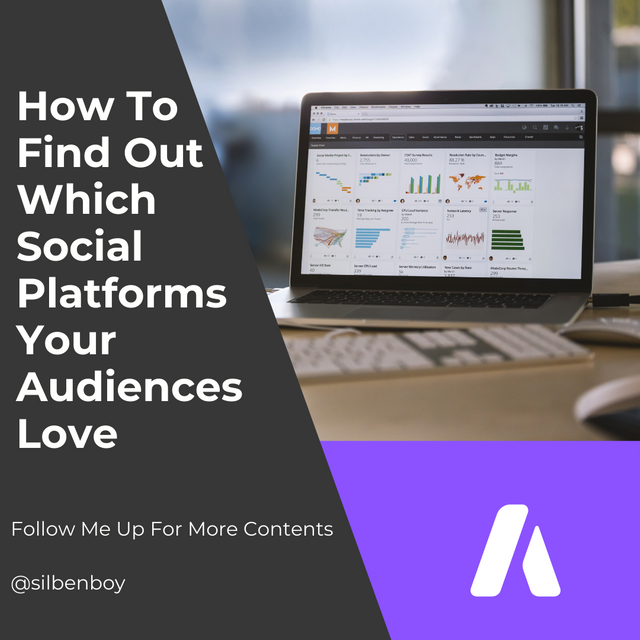How To Find Out Which Social Platforms Your Audiences Love
Hello Guys, Hope y'all are Fresh and doing well. Today I'm sharing an article that tells you how to attract more audience to your platform. Thank y'all and take your time reading, if there is any question don't hesitate to drop it on the comments.

Whether you stick to modest LinkedIn updates or consider yourself a full-blown influencer, social media’s place in the digital marketing landscape can’t be overstated. Not only are social platforms one of the most cost-effective ways to promote your company, but they offer unparalleled access to your target audience. The question is, which platforms should you focus on when time and budgets are limited?
It’s not an easy answer. Below are just a few ways to determine which social platforms may be worth your efforts.
Flesh out your ideal client persona.
If you already have a handle on your specific target audience personas and are sure they’re updated and accurate, congrats—you’re ahead of the game. (What’s your secret?) If not, don’t fear.
Making sure you have an accurate ideal client persona in mind will help you better create content that speaks to them on social and elsewhere. Plus, you’ll know that you’re putting your efforts into the platforms they use most often.
You can build your personas by:
• Looking at the demographics of your current clients.
• Sending out a research survey to clients and prospects.
• Asking your sales team what patterns they’ve noticed.
• Thinking about the job titles, price points and other features you want to attract.
• Creating an avatar complete with name, age, region, industry, etc.
Dig into the data.
One of the benefits of having a business-type social media page over a personal one is the data you can track. Along with information from your customer relationship management (CRM) tool and Google Analytics, social media insights can tell you plenty about your audience.
First, see which platforms have garnered you the most followers. From there, check out the insights and see which posts have resonated most with your audience. Often, you can see everything from engagement and likes to how many saves and shares a post has. (Just keep in mind that organic social content gets a limited reach and won’t always surface to all of your followers.)
You can also zoom out and research which platforms tend to resonate most with different demographics. These days, Facebook is more popular with older generations than Millennials and Gen Z. These age groups tend to gravitate more toward Instagram and TikTok, respectively.
Check out social platform ad libraries.
Ad libraries are a great resource for seeing the kind of content that is doing well on a particular platform. You can use these libraries to glean inspiration for your own organic and paid efforts.
The type of ad info you’ll get depends on the platform. On Meta (formerly Facebook), for example, they’re transparent about “who funded the ad, a range of how much they spent, and the reach of the ad across multiple demographics.”
If you’re seeing an industry, product or service similar to yours that’s having success on a platform via their ads, it may be worth investing more into that platform yourself.
Keep an eye on competitors.
Similar to the saying we're used to hearing, keep your friends close and your competitors closer. But if your competitors are doing well on a particular platform, that’s usually a good indicator that you may want to give it more attention as well.
Of course, you want to keep your social presence authentic and not simply mirror what others in your field are posting. Rather, brainstorm ways to use content to reach your audience using your brand’s unique voice, offering and positioning.
Go to the source.
With the right approach, happy customers can become brand evangelists. While you want to be thoughtful about how you reach out to them, especially when asking for something, the odds are good that they’ll be open to giving you feedback—especially if it could improve their experience.
There are a handful of ways you can gather information about your audience’s social media preferences:
• In an incentivized feedback survey.
• During a meeting or status call.
• On a lead form.
• Via a pop-up on your site.
• In an email marketing campaign or newsletter.
The Takeaway
One of the great things about social media is that, for the most part, these platforms don’t take themselves too seriously. Whether you’re creating ads or organic content, the posts that seem to do best are the ones that focus on bold visuals, witty copy and unique twists on trends.
No matter which social platforms your audience loves, try not to get too bogged down in the facts and figures. Depending on your company and industry, social media may mainly be a way for you to grow brand awareness, engage directly with your audience and showcase your company’s personality. Sometimes that’s all you need.
I like your Thumbnail thou.
Thank you for the information. Keep it up and continue with the wonderful work.
You have great contents. Make sure you drop us more and more of this great contents.